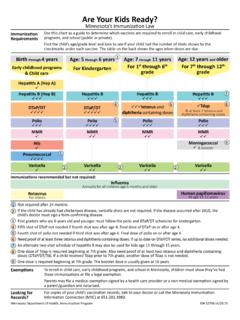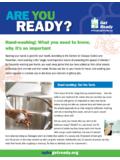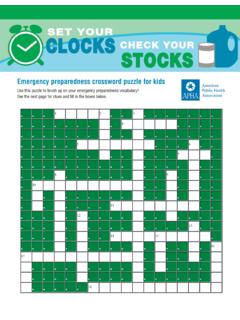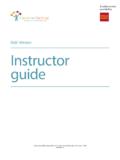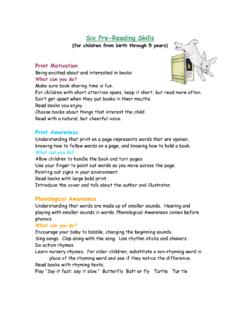Transcription of No Kidding About Bullying: 125 Ready-to-Use …
1 He always teased me About my not being able to do something. Even though I knew what he said wasn t true, it killed me inside. 4th-grade boy I didn t mean to hit him that hard. I just wanted him to stop saying stuff About me. He tried to hit me, but I ducked and kicked his shin. I was trying to tell him to stop, but he hit my arm. I didn t want to fight but I had no choice. 6th-grade girl People call me names all the time. They call me fatty and fat boy and apple tree and cherry cheeks. I would like to know how to stop it. 3rd-grade boy I try to ignore conflicts, but if I can t, I just hurt. 5th-grade girl I ve been through a lot. These kids don t like the way I look. They call me pimple face and the other day after school they kicked me in the ribs. I am so sick of being picked on.
2 4th-grade boy Anger and bullying are among the major issues I see as a teacher. 4th-grade teacher Things seem to start small and quickly grow bigger. 5th-grade teacher How do you end the name-calling? This is a BIG problem. I have tried many things, and I have not found a way that really works. I am not seeing success this year. 3rd-grade teacherIntroductionThe quotes you just read are from students and teach-ers who were surveyed or interviewed for this book. Before I wrote the book, my publisher and I con-ducted a survey of 2,171 kids and 59 teachers in the United States and Canada to find out how bullying , peer cruelty, and conflicts impact their lives. Survey responses confirmed what media reports continue to tell us that bullying is one of the greatest challenges our kids face today.
3 Educators consistently reported that they were troubled by the bullying , name-calling, and meanness that take place among their students. Students expressed the same concerns: Seventy-three percent of the kids we surveyed said other kids are somewhat to very mean to each other. Forty-four percent said bullying happens often, every day, or all the time, and over 40 percent said they 1 From No Kidding About bullying by Naomi Drew, , copyright 2010. Used with permission of Free Spirit Publishing Inc.,Minneapolis, MN; 800-735-7323; All rights No Kidding About BullyingNo Kidding About bullying 3see conflicts happening often or every day. Students also expressed, sometimes longingly and often poi-gnantly, that they don t want to be hurt by bullying . Sixty-three percent of the children said that they wanted to learn how to stay out of physical fights.
4 Eighty percent said that they wanted to learn ways to stop the bullying , avoid fighting, get along better with peers, and work out problem of bullying persists despite the aware-ness and attention that many schools, teachers, and parents have put toward diminishing it. The purpose of No Kidding About bullying is to help teachers and kids by getting to the root of the problem. While the book s goal is to prevent bullying , its approach to doing so is broad. Some of our most important work as educators is teaching kids how to navigate through an increasingly complex and violent world: helping them interact with all kinds of people and showing them how to work out differences, respect others, and be compassionate human beings who disavow cruelty in all its forms. Navigating the world success-fully requires understanding that being respectful will get you a lot further in life than being mean-spirited.
5 It requires remembering that inside every human being is a heart that beats and a mind that feels pain when unkind words are spoken. It requires choosing to be a person of conscience who does the right thing even when no one is looking. These are the concepts and behaviors kids need to absorb in order to elimi-nate bullying and to lead rewarding lives. In my work as an educator focused on peacemak-ing, I have seen firsthand the transformation that can occur as kids begin to see the power of their own compassion and recognize the personal well-being that comes with following their own conscience. I have witnessed the empowerment students feel when they learn to stop and think before acting and to use deep breathing, self-calming, respectful listening, and peaceful conflict resolution to help them through challenging situations.
6 By instilling these attitudes and practices in your students, you can establish a peaceful classroom environment while teaching kids skills that will enable them to have positive, peaceful relationships throughout their lives. Facts About bullying and Conflict in Children s LivesResearch on the Impact of BullyingWhat s actually happening among our children? According to recent studies: The intensity of aggression involving children and teens has escalated Children are becoming involved in aggression at ever-younger In the United States, youth violence is the second leading cause of death for young people ages ten and Kids who are bullied are five times more likely to be depressed and far more likely to be 50% of students in the United States are Not only do bullying and cruelty create an under-current of fear and mistrust among kids, they also affect learning and development, and can even impact a child s future mental health.
7 According to the Center for Social and Emotional Education, When children are bullied in an intermittent but ongoing manner it derails healthy development and a student s capacity to learn. In fact, more and more evidence suggests that this type of harassment leads to significant adolescent and adult psychiatric problems. 6 bullying expert Dr. Susan Limber, in proceedings before the American Medical Association, noted, Children and youth who are bullied are more likely than other children to be depressed, lonely, anxious; have low self-esteem; feel unwell; and think About suicide. 7 Data regarding school shootings is even more alarming. According to The Final Report and Find-ings of the Safe School Initiative conducted by the Secret Service and the Department of Education, even though the majority of attackers in thirty-seven school shootings came from two-parent families, had good grades, were involved in school activities, and had never been in trouble before, they shared the following characteristic: Almost three-quarters of the attackers felt persecuted, bullied, threatened, attacked, or injured by others prior to the incident.
8 In several cases, individual attackers had From No Kidding About bullying by Naomi Drew, , copyright 2010. Used with permission of Free Spirit Publishing Inc.,Minneapolis, MN; 800-735-7323; All rights No Kidding About BullyingNo Kidding About bullying 3experienced bullying and harassment that was long-standing and severe. In some of these cases the experience of being bullied seemed to have a significant impact on the attacker and appeared to have been a factor in his decision to mount an attack at the school. In one case, most of the attacker s schoolmates described the attacker as the kid everyone teased. 8 The negative impact of bullying goes beyond students who are bullied, affecting those who see it take place as well. According to the American Psychological Association, research suggests that Students who watch as their peers endure the verbal or physical abuses of another student could become as psychologically distressed, if not more so, by the events than the victims themselves.
9 Bullies and bystanders may also be more likely to take drugs and drink alcohol. 9 Kids who bully also are adversely affected. Accord-ing to the American Academy of Pediatrics, Children labeled by their peers as aggressors or bullies at age eight are more likely to end up incarcerated and are less likely to be steadily employed and in stable long-term romantic relationships by the time they reach age thirty. Consequently, bullying prevention programs have a long-term benefit for both bullies and victims. 10 Research on What Impacts Kids PositivelyAnyone who teaches knows how contagious emo-tions and behaviors are. If you ve ever spent a year with a conflict-ridden class where bullying is preva-lent, you probably know the feeling of throwing your hands up in frustration as bickering and meanness infected the entire atmosphere in your the good news is, positive emotions and behaviors also are contagious.
10 Dr. Nicholas A. Christakis, a researcher at Harvard Medical School, explains, Emotions have a collective existence they are not just an individual phenomenon. He goes on to say that how you feel depends not just on your choices and actions, but also on the choices and actions of people .. who are one, two, and three degrees removed from you. 11 People one, two, and three degrees removed .. as in a class. And when positive emotions and behaviors are sparked in a class, they spread. Christakis and his research partner, James Fowler, hypothesize that behaviors spread partly through the subconscious social signals that we pick up from those around us, which serve as cues to what is considered normal behavior. Another likely cause of social contagions is mirror neurons in our brains, which cause us to mimic what we see in positive contagious emotions can have a powerful effect in the classroom.
